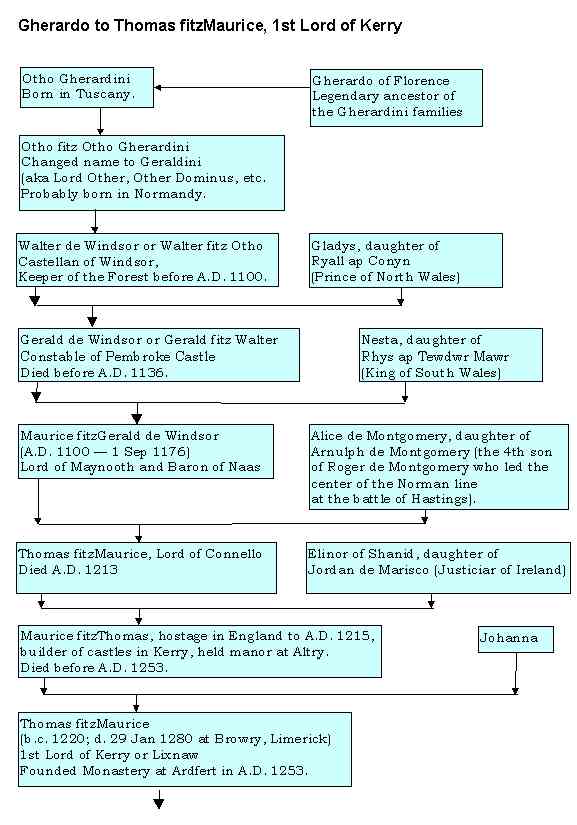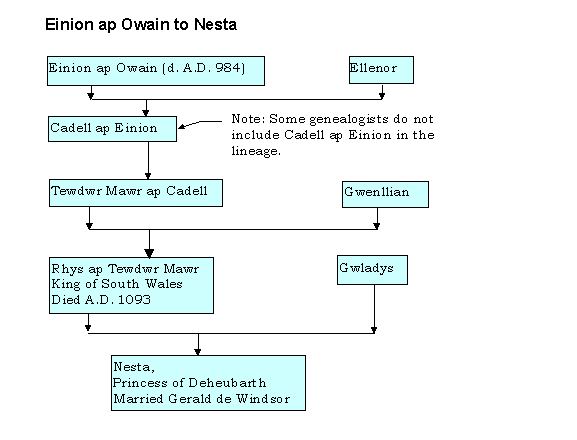
| This chapter in the history of the FITZMAURICE families begins with legends and gradually acquires substance as we approach 1100 A.D. Although the story is fairly well substantiated for 1100 A.D. to about 1220 A.D., I am sensitive to the need for greater access to primary sources even for that period. |



|
Legendary Ancestors The most ancient documents on which I have relied are the Domesday Book (A. D. 1086) and the writings of Gerald of Wales (c. 1146-c. 1223). They say nothing about the ancestors of Lord Other, the father of Walter fitzOther (aka Walter de Windsor or Gualterius filius Otheri). There were many people named Other or Otho in the 10th and 11th centuries. Otho I, Otho II, and Otho III were the first three Holy Roman Emperors (962 — 1002). They ruled Lombardy from A.D. 951. All three emperors were Saxons. Among the contemporary variations of the name "Otho" or "Other" were "Oitir" (Old Irish), "Ottar (Old Norse), and "Ohtere" (Anglo Saxon).15 Bishop Odo (c. 1030--1097) of Bayeux, a half-brother of William I, fought at Hastings and commissioned the Bayeux Tapestry. Because the name "Other" (with variations in spelling) was so common, it is not surprising that several speculative legends evolved concerning the ancestors of Lord Other. There are three legends (first printed several centuries after the death of Lord Other) which state respectively that the ancestors of Other came from Tuscany, Helgoland, and Spain. Legendary Tuscan Ancestors The legendary ancestor memorialized by the family name was said to be Gherardo, who was said to have held the land on which Florence now stands. The Gherardini were one of the seigniorial families that fell when the Republic of Florence was founded circa A.D. 1250.211 The emigrant Gherardini who was ancestor to the FITZMAURICE families was said to be Otho or Odher (probably pronounced as "Oh-tair" with the accent on the first syllable). The legendary Other is said to have gone to Normandy with King Canute of England who passed through Florence on his way home from a pilgrimage to Rome. This legendary Other subsequently went to England. According to one story16, 56, this was about the time of King Canute's marriage with Emma, daughter of Richard Second, Duke of Normandy, and widow of King Ethelred, who died in A.D. 1016. Another account says that Other went to England with Edward the Confessor when the latter was called back from exile to be King of England. That would have been circa A.D. 1042. Since A.D. 1016 and A.D. 1042 were only 26 years apart, the two stories are not contradictory. As a supporter of King Edward during his exile, Otho Gherardini would have had great power in England. While the Tuscan origin of the Geraldines is supported by the Royal Genealogical Data Base205 maintained at the University of Hull in England, some other genealogists reject all details of this legend. Absent documentation, I have no opinion. Legendary Helgoland Ancestors Legendary Spanish Ancestors Wood does not quote any documentary sources for this fanciful genealogy. |
|
Lord Other Lord Other (aka Other Dominus, Otho fitz Othoer, Other fitz Othoer, etc.) is the most ancient of the direct male ancestors of the FITZMAURICE Lords of Kerry concerning whom there still exist contemporary documents. There is no documentary record of any of his ancestors. The Domesday Book of A.D. 1086 indicates that he was the father of Walter of Windsor. |
|
Walter fitz Other Walter fitz Other (or Walter de Windsor), the son of Lord Other, was tenant in chief of lands in Berkshire, counties Buckingham, Middlesex, Surrey, and Hampshire at the time of the Domesday Survey in A.D. 1086, and was Castelan of Windsor and Keeper of the Forest before A.D. 1100. Walter married Beatrice. Walter and Beatrice had three children:
|
|
Gerald of Windsor (Born A.D. 1070 in Windsor, Berkshire,
England; Gerald fitzWalter (or Gerald of Windsor), the second son of Walter fitzOther, was appointed by Henry I to be Constable of Pembroke Castle and Pres. of Pembroke County. In A.D. 1095, Gerald of Windsor married Nesta, daughter of Rhys ap Tudor Mawr (Prince of South Wales). Gerald and Nesta had four children:
|
|
Nesta (or Nest), Princess of Deheubarth The earliest Welsh ancestor of the first Lord of Kerry with whom we can associate a date was Gwriad of Man who died in A.D. 825.
Gwriad of Man had a son called Marvyn Vrych (d. A.D. 843) who became the King of Powys17. Rhodri Mawr , the son of Marvyn, became King of Powys upon the death of his father. His mother was Esyllt, Queen of North Wales. He married Angharad, heiress of South Wales and daughter of Meuric ap Dyfnwal (possibly the first known "Maurice" in our family) Lord of Caerdigan. Rhodri Mawr ruled Powys, North Wales, and South Wales. By his wife Angharat, Rhodri Mawr, who was slain in A.D. 876, had at least two children:
|
|
(Born A.D. 1100; died 1 Sep 1176
at Wexford, Ireland)
In A.D. 1168, Dermot MacMorrogh, King of Leinster, driven from his territory by Roderick O'Conor, High King if Ireland, sought assistance from the Norman-Welsh and succeeded in enlisting in his cause Richard de Clare, Earl of Pembroke (called Strongbow). Having reached St. David's, on his way back to Ireland, Dermot was hospitably received by David fitzGerald (son of Gerald of Windsor), Bishop of the diocese. According to Burke's Peerage, the Bishop persuaded his brother, Maurice fitzGerald, and his half-brother, Robert fitzStephen to assist MacMorrough with their forces.
Sometime after achieving success in the invasion of Ireland, Strongbow granted to Maurice fitzGerald the middle cantred of Offelan, in which Naas was situated. Offelan was a district quite distinct from Offaly. Maurice married Alice de Montgomery and had six sons:
The information above was all obtained from the 1970 edition of Burke's Peerage. I am inclined to accept that source for the present. From at least the end of the 16th century to at least the mid19th century, English and Irish genealogists wrote that William fitzMaurice (the eldest son of Maurice fitzGerald of Windsor) was the ancestor of the FitzMaurices of Kerry via his son Raymond le Gros.16 There is now general agreement that Raymond le Gros had no children. One modern Irish genealogist102 argues that Thomas fitzMaurice (the 1st Lord of Kerry) was the son of Maurice fitzThomas of Molahiffe (d. 1306), son of Thomas fitzRobert (d. after 1261), son of Robert fitzMaurice, the youngest son of Maurice fitzGerald (Lord of Maynooth and Baron of Naas, d. 1176). |
|
Alice de Montgomery Alice was the daughter of Arnulph de Montgomery. Arnulph was the fourth son of Roger de Montgomery, who led the center of the Norman army at the Battle of Hastings. Roger took his name from the castle Sainte Foi de Montgomery in the diocese of Lisieux in Normandy. (Another branch of the Montgomery family took its name from Saint Germain de Montgomery in Calvados).40 The legendary progenitor of the Montgomery family was named Gomer:
Roger was made an Earl with large holdings of land in Wales. His family gave its name to the county of Montgomeryshire. In A.D. 1102, Robert de Belesme, a son of Roger de Montgomery, rebelled against Henry I and was banished from England.40 The Earls of Eglinton descended from other sons of Roger de Montgomery.40 The family of Montgomery in Scotland was founded by Robert de Montgomery in the second part of the 12th century when he obtained the lands of Eaglesham in Renfrewshire.40 The family is that of the Earls of Eglinton and Winton.40 The first Earl of Shrewsbury was named Robert de Montgomery. He was alive before A.D. 1123.40 Alice de Montgomery married Maurice fitzGerald (d. 1176). They had six sons:
The mother of Alice de Montgomery was Lafeacott O'Brien. The O'Brien and the MacCarthy families had been warring with each other in southwestern Ireland for many years prior to the Norman invasion of Ireland. Lafeacott was apparently a persuasive woman. When her son-in-law, Maurice fitzGerald, invaded Ireland in 1171, he took by conquest part of the MacCarthy territory. Initially at least, Maurice did not seize any O'Brien territory of which I have any record. Most people named O'Brien are descended from Brian mac Cennéidigh, the Ard-Righ (High King) of Ireland usually known as Brian Bóru. Since Lafeacott O'Brien was born only about 150 years after the army of Brian Bóru defeated the Vikings at Clontarf in A.D. 1014, she was undoubtedly aware of her famous ancestor and careful about the spelling of her name. In later generations, the families of (O) Byrne, O'Broin, and Bryan sometimes changed the spelling of their name to O'Brien.84 The father of Alice de Montgomery was probably the same Arnulph de Montgomery who, circa A.D. 1100, founded the Benedictine priory in Monkton known as Pembroke priory, a cell of Seez. |
|
Thomas fitzMaurice fitzGerald of Connello79 Died A.D. 1213 Third son of Maurice fitzGerald (d. 1176), Lord of Naas and Maynooth, and Alice de Montgomery. A significant event during the lifetime of Thomas fitzMaurice of Connello was the death of Henry II at Chinon in Touraine on 6 July 1189. Henry seemed to be more concerned with retaining control over part of France than with completing the conquest of Ireland. Thomas married Elinor of Shanid, daughter of Jordan de Marisco (Justiciar of Ireland). Thomas was survived by two sons:
|
|
Maurice fitzThomas fitzMaurice Died before 1253 Maurice was a hostage in England until 1215 (Pat. Roll 17 John, MS. 19). He was released and returned to Ireland after his father died. Maurice was the younger son of Thomas fitzMaurice of Connello (d. 1213) and Elinor, daughter of Jordan de Marisco (Justiciar of Ireland). Maurice built the castle of Molahiffe and others along the river Maine in Kerry. He held the Manor of Altry in Clanmaurice.79 According to Cusack86, Maurice married a woman named Johanna and was survived by one son, Thomas fitzMaurice, the First Lord of Kerry. According to Ref. 65, Maurice the hostage married the heiress of the McElligotts of Galey. There are at least five popular theories concerning the origin of the name McElligott. The current theory is that McElligott came from FitzElyoth which came from FitzElias, the name of a Cambro-Norman family in Kerry from the middle of the 13th century. |